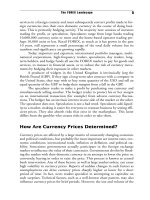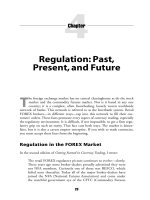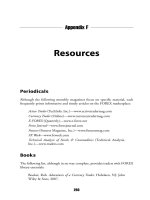Lecture Accounting: What the numbers mean (5/e) - Chapter 11: Financial statement analysis
Bạn đang xem bản rút gọn của tài liệu. Xem và tải ngay bản đầy đủ của tài liệu tại đây (153.7 KB, 40 trang )
CHAPTER 11
FINANCIAL STATEMENT
ANALYSIS
McGrawHill/Irwin
©The McGrawHill Companies, Inc., 2002
Learning Objectives
1. How can liquidity measures be
influenced by the inventory cost-flow
assumption used?
2. How do suppliers and creditors use a
customer’s payment practices to
judge liquidity?
3. What are the influences of alternative
inventory cost-flow assumptions and
depreciation methods on turnover
ratios?
McGrawHill/Irwin
©The McGrawHill Companies, Inc., 2002
Learning Objectives
4. How are the number of days’ sales in
accounts receivable and inventory
used to evaluate the effectiveness of
the management of receivables and
inventory?
5. What is the significance of the
price/earnings ratio in the evaluation
of the market price of a company’s
stock?
McGrawHill/Irwin
©The McGrawHill Companies, Inc., 2002
Learning Objectives
6. How are dividend yield and the
dividend payout ratio used by
investors to evaluate a company’s
common stock?
7. What is financial leverage, and why
is it significant to management,
creditors, and owners?
8. What is book value per share of
common stock, how is it calculated,
and why is it not a very meaningful
amount for most companies?
McGrawHill/Irwin
©The McGrawHill Companies, Inc., 2002
Learning Objectives
9. How can common size financial
statements be used to evaluate a
firm’s financial position and results
of operations over a number of
years?
10. How can operating statistics using
physical, or non-financial data, be
used to help management evaluate
the results of the firm’s activities?
McGrawHill/Irwin
©The McGrawHill Companies, Inc., 2002
Learning Objective 1
• How can liquidity measures be
influenced by the inventory
cost-flow assumption used?
McGrawHill/Irwin
©The McGrawHill Companies, Inc., 2002
Financial Statement Analysis
Ratios
• Used to facilitate the interpretation of
an entity’ financial position and results
of operations
• Can be classified into four groups:
– Liquidity
– Activity
– Profitability
– Debt, or financial leverage
McGrawHill/Irwin
©The McGrawHill Companies, Inc., 2002
Liquidity Measures
• The balance sheet carrying values of
inventory will depend on the cost-flow
assumption used
• Cannot compare firms using different
inventory cost-flow assumptions
• Firms often report the LIFO reserve –
the difference between LIFO an FIFO
inventory values
McGrawHill/Irwin
©The McGrawHill Companies, Inc., 2002
Liquidity Ratios
• Working capital =
Current assets – Current liabilities
• Current ratio =
Current assets
Current liabilities
• Acid-test ratio =
Cash + Accounts receivable
Current liabilities
McGrawHill/Irwin
©The McGrawHill Companies, Inc., 2002
Learning Objective 2
• How do suppliers and creditors
use a customer’s payment
practices to judge liquidity?
McGrawHill/Irwin
©The McGrawHill Companies, Inc., 2002
Customer’s Payment Practices
• Suppliers and creditors want to know
if a firm is paying its bills promptly
• This information may be obtained
from other suppliers, credit bureaus,
and Dun & Bradstreet reports
• Credit bureaus and credit rating
agencies provide a graded rating for
firms
McGrawHill/Irwin
©The McGrawHill Companies, Inc., 2002
Learning Objective 3
• What are the influences of
alternative inventory cost-flow
assumptions and depreciation
methods on turnover ratios?
McGrawHill/Irwin
©The McGrawHill Companies, Inc., 2002
Activity Measures
• Focus primarily on the relationship
between assets and sales
• In computing activity measures, average
assets is used
• Average asset amounts include inventory
and fixed assets
• The values of inventory (based on cost-flow
assumptions) and fixed assets (based on
book cost less accumulated depreciation)
depend on the cost-flow assumptions and
depreciation methods used
McGrawHill/Irwin
©The McGrawHill Companies, Inc., 2002
Activity Ratios
• Total asset turnover =
Sales
Average total assets
• Inventory turnover =
Cost of goods sold
Average inventories
• Number of days’ sales in accounts
receivable =
Accounts receivable
Average days’ sales
McGrawHill/Irwin
©The McGrawHill Companies, Inc., 2002
More Activity Ratios
• Average days’ sales =
Annual sales
365
• Number of days’ sales in inventory =
Inventory
Average days’ cost of goods sold
• Average days’ cost of goods sold =
McGrawHill/Irwin
Average cost of goods sold
©The McGrawHill Companies, Inc., 2002
Learning Objective 4
• How are the number of days’
sales in accounts receivable and
inventory used to evaluate the
effectiveness of the management
of receivables and inventory?
McGrawHill/Irwin
©The McGrawHill Companies, Inc., 2002
Number of Days’ Sales in
Accounts Receivable
• Assesses the efficiency of managing accounts
receivable
• The sooner accounts receivable are collected,
the sooner cash is available for use in the
business
• Generally, the higher the turnover and lower
the number in days’ sales, the better
• An increase in the age of accounts receivable
is a warning that profitability and liquidity may
be weakening
McGrawHill/Irwin
©The McGrawHill Companies, Inc., 2002
Number of Days’ Sales
in Inventory
• Assesses the efficiency of managing
inventory
• The lower that inventories can be
maintained relative to sales,the less
inventory that needs to be financed
with debt and the greater the return on
investment
• Trend in the efficiency of managing
inventory is the important factor
McGrawHill/Irwin
©The McGrawHill Companies, Inc., 2002
Profitability Measures
• Operating income is frequently used in
ROI calculations because it is a more
direct measure of management’s
activities
• Average ROI based on net income for
most American firms is between 7%
and 10%
• Again, trends are important
McGrawHill/Irwin
©The McGrawHill Companies, Inc., 2002
Profitability Ratios
• ROI =
Return (Net income)
Investment (Average total assets)
• DuPont model =
Margin
x
Net income
x
Sales
McGrawHill/Irwin
Turnover
Sales
Average total assets
©The McGrawHill Companies, Inc., 2002
More Profitability Ratios
• ROE =
• Dividend yield =
Net income
Average total owners’ equity
Annual dividend per share
Market price per share of stock
• Dividend payout ratio = Annual dividend per share
Earnings per share
McGrawHill/Irwin
©The McGrawHill Companies, Inc., 2002
Learning Objective 5
• What is the significance of
the price/earnings ratio in the
evaluation of the market price
of a company’s stock?
McGrawHill/Irwin
©The McGrawHill Companies, Inc., 2002
Price/Earning Ratio
• P/E ratio =
Market price of a share of common stock
Earnings per share of common stock
• Used extensively to evaluate the market
price of a firm’s common stock relative to
that of other firms and the market as a whole
• Also called earnings multiple
McGrawHill/Irwin
©The McGrawHill Companies, Inc., 2002
Importance of P/E Ratio
• Investors can earn a return on stock two
ways:
– Through dividends
– Through increases in the market value
of the stock
• Market price reflects expectations of future
dividends – which depend on earnings
• Typically, manufacturing firms’ P/E ratio
ranges from 12 to 18
McGrawHill/Irwin
©The McGrawHill Companies, Inc., 2002
Learning Objective 6
• How are dividend yield and
the dividend payout ratio
used by investors to evaluate
a company’s common stock?
McGrawHill/Irwin
©The McGrawHill Companies, Inc., 2002









